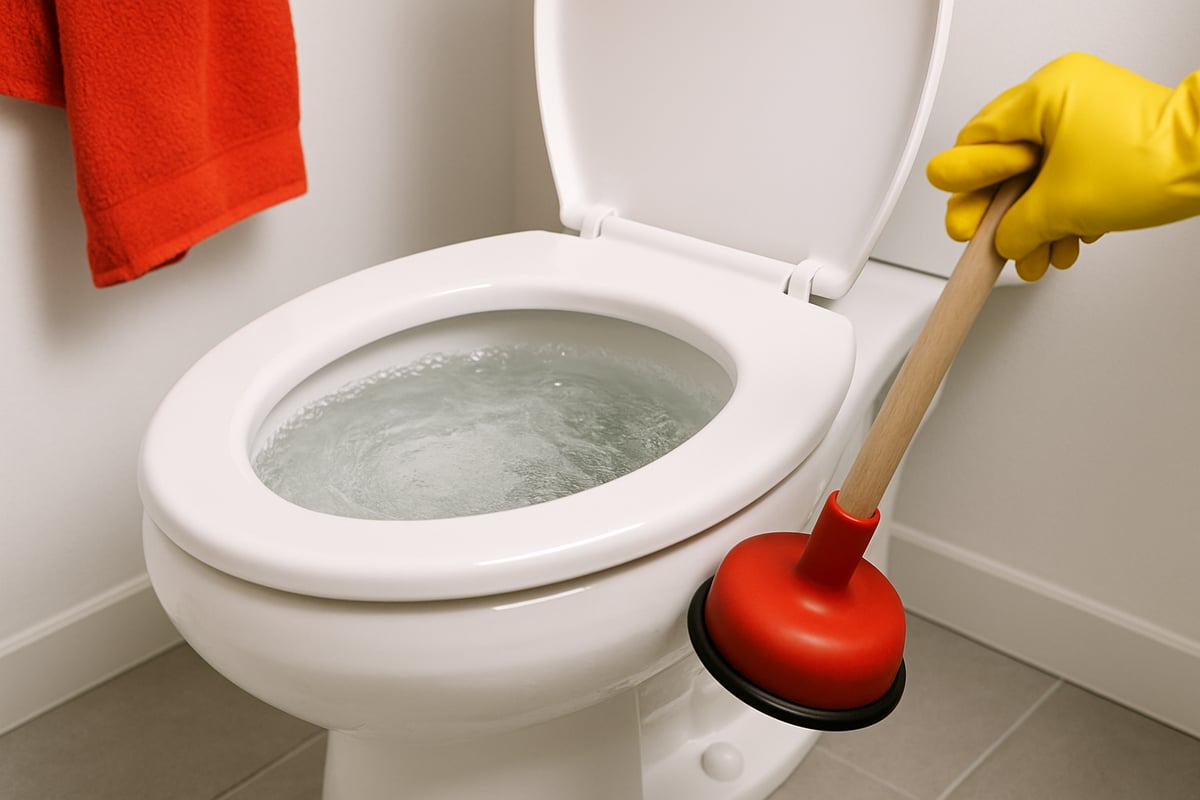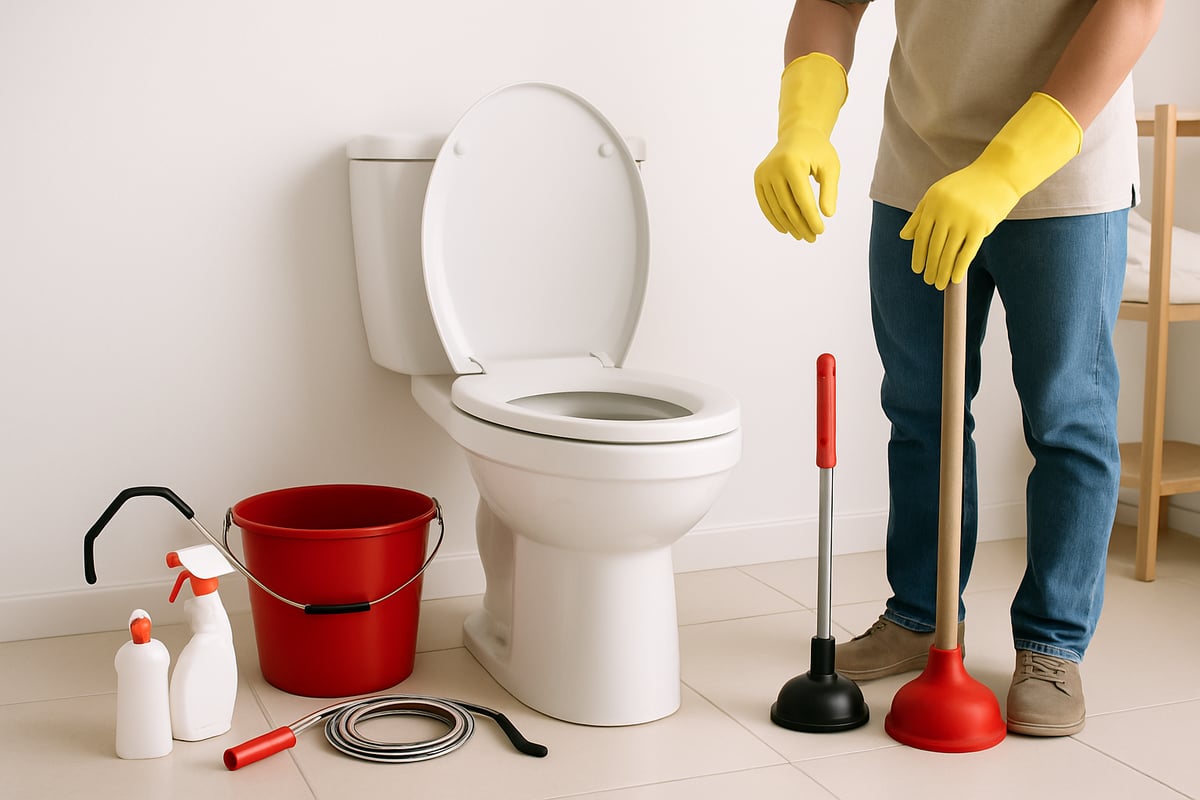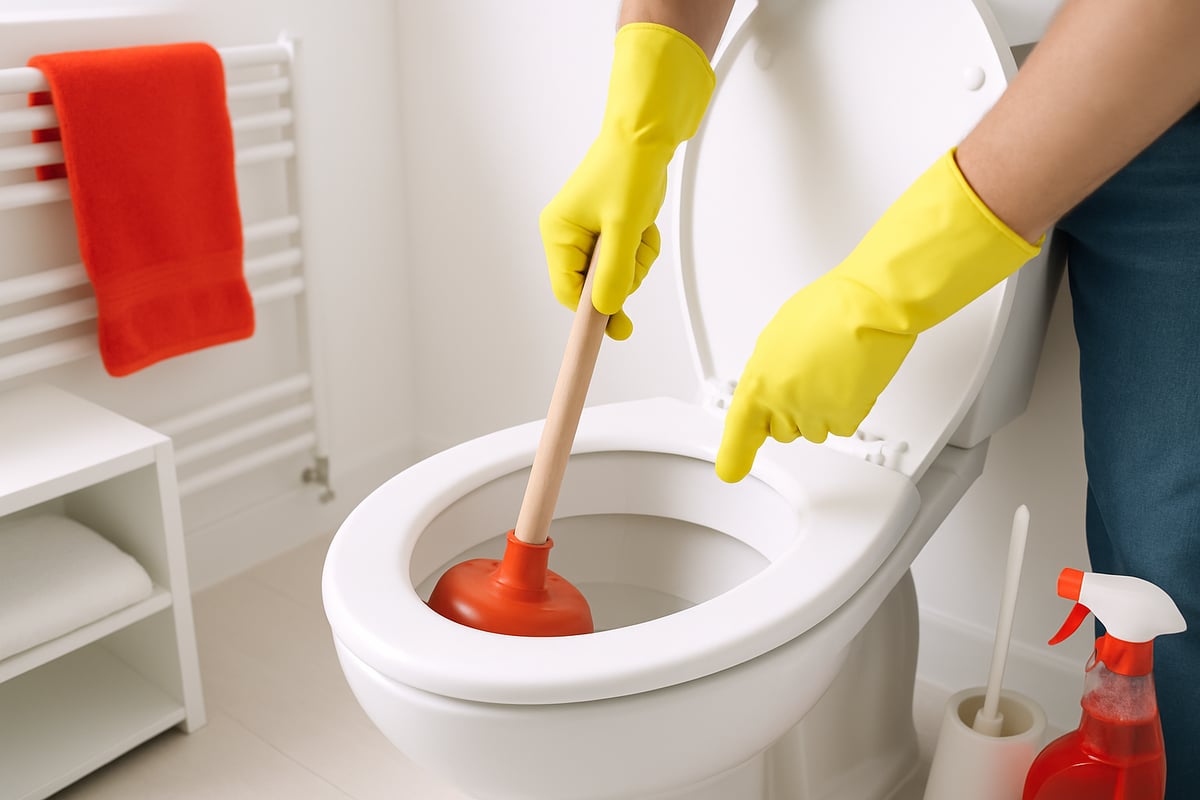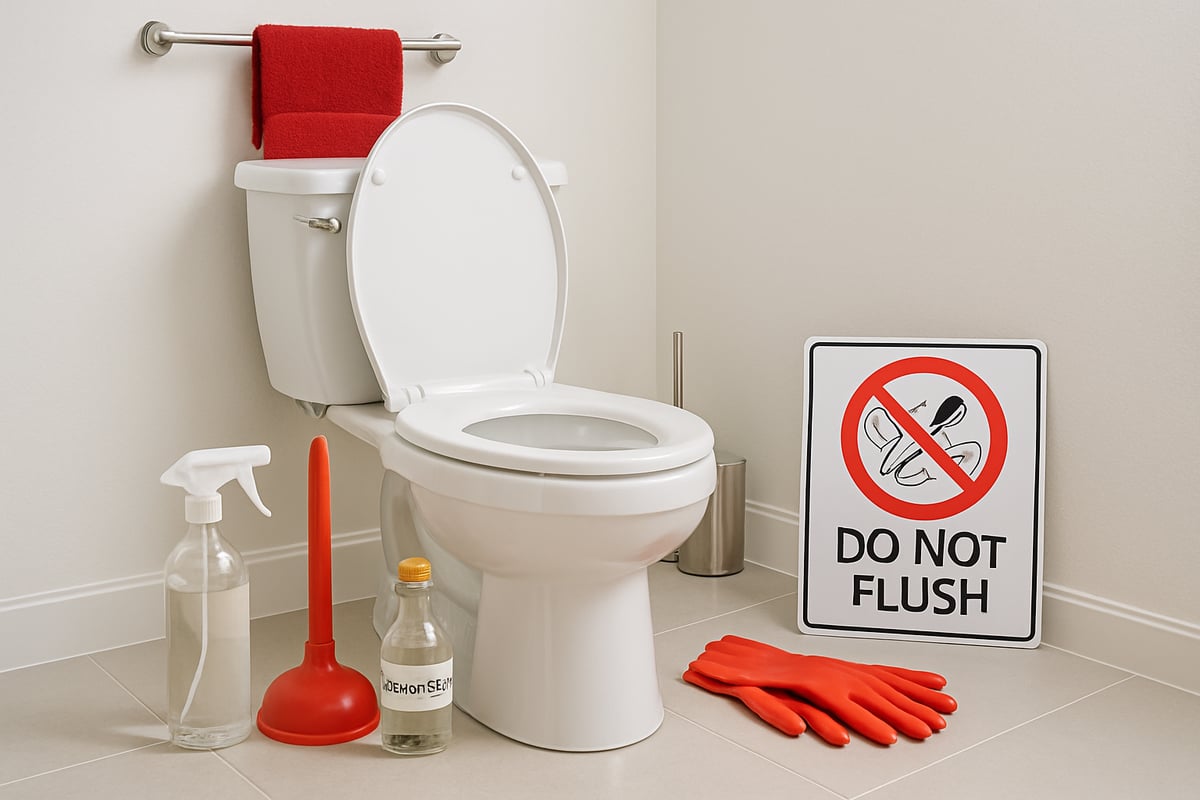Step-By-Step Guide to Unblock a Toilet in 2025
Imagine this: you are about to welcome guests, but suddenly, you discover your toilet is blocked. Panic rises, but the good news is you can fix it yourself.
This step-by-step guide will show you how to unblock a toilet in 2025 using proven methods. We will help you identify the blockage, gather essential tools, and follow the safest, most effective techniques.
You will also learn how to prevent future problems and know when it is best to call a professional. Ready to restore your peace of mind? Let’s get started.
Recognising a Blocked Toilet: Signs and Causes
Dealing with a blocked toilet can be stressful, especially if you are unsure what to look for. Before you try to unblock a toilet, it is important to recognise the warning signs and understand the causes behind the issue. This knowledge will help you choose the right solution and prevent further problems.

Common Signs Your Toilet is Blocked
Spotting the early signs can make it much easier to unblock a toilet before it gets worse. Look out for these common indicators:
- Slow drainage after flushing, where water lingers or drains sluggishly.
- Water rising higher than usual in the bowl.
- Persistent gurgling noises from the toilet or nearby pipes.
- Unpleasant odours that do not go away, even after cleaning.
- Overflowing or standing water in the bowl, especially after a flush.
- Fluctuating water levels that seem unpredictable.
- Difficulty flushing, or a noticeably weak flush.
As highlighted by experts, “The water doesn’t disappear down the toilet, it fills up the bowl.” If you notice one or more of these signs, it is time to investigate further and prepare to unblock a toilet.
Typical Causes of Toilet Blockages
Understanding why blockages happen is the first step to successfully unblock a toilet. Several everyday habits and hidden issues can lead to clogs, including:
- Using too much toilet paper in a single flush.
- Flushing non-flushable items like wipes, sanitary products, or cotton buds.
- Children accidentally dropping toys or small bottles into the toilet.
- Build-up of waste or limescale inside the pipes.
- Tree roots or debris blocking external drains.
- Issues with the main sewer line or plumbing vent.
Did you know that wet wipes are now one of the leading causes of toilet blockages in UK homes? According to the UK drainage habits survey 2025, many people are unaware that even “flushable” wipes can cause serious problems. Everyday mistakes like these make it even more important to unblock a toilet promptly and avoid long-term damage.
Assessing the Severity of the Blockage
Not all blockages are created equal. Before you attempt to unblock a toilet, consider the following:
Check if the problem is localised to one toilet or if it affects other fixtures like sinks or baths. A minor blockage usually causes slow drainage or a weak flush, while a severe clog might cause water to overflow or back up into other drains.
If you spot persistent issues, such as water regularly overflowing or foul smells coming from multiple fixtures, this could indicate a bigger problem with your drainage or sewer system. Ignoring these warning signs can lead to costly water damage and repairs down the line. Always assess the severity before deciding how to unblock a toilet safely.
Preparing to Unblock Your Toilet: Tools, Safety, and Setup
Getting ready to unblock a toilet is just as important as the unblocking itself. Preparation ensures you stay safe, protect your bathroom, and give yourself the best chance of success. Let’s break down what you’ll need and how to set up for a smooth process.

Essential Tools and Materials for Unblocking
Before you attempt to unblock a toilet, gather all the essential tools. Having the right equipment can make the job easier and help prevent further mess or damage.
- Plunger (either cup or flange style)
- Drain auger or toilet snake
- Thick rubber gloves and protective eyewear
- Bucket, old towels, and cleaning supplies
- Eco-friendly cleaners like bicarbonate of soda and vinegar, or chemical cleaners
A plunger is the most common tool and costs around £4, while a drain auger is about £5. Using proper tools is the first step to unblock a toilet efficiently and safely.
Safety Precautions and Hygiene Tips
Safety should be your top priority when you need to unblock a toilet. Always wear gloves to avoid direct contact with contaminated water. Protective eyewear can shield your eyes from splashes.
Ventilate the bathroom by opening a window or turning on an extractor fan. Keep children and pets well away from the area while you work. After you unblock a toilet, thoroughly disinfect all tools and clean any surfaces that may have come into contact with wastewater. When using tools, be gentle to avoid scratching the porcelain.
Preparing the Area and Yourself
A tidy and organised workspace helps you unblock a toilet without unnecessary stress. Clear away any items near the toilet, such as mats or toiletries, to give yourself space to work.
If you expect any overflow, turn off the water supply at the isolation valve. Place towels around the base of the toilet to soak up any accidental spills. Have a bucket ready in case you need to remove excess water, and keep a waste bin or bag nearby for any non-flushable debris. Being prepared means you can focus on the task at hand and unblock a toilet more efficiently.
When to Avoid DIY and Call a Professional
Sometimes, it’s best not to attempt to unblock a toilet on your own. If you notice blockages affecting multiple drains, recurring clogs, or foul smells coming from more than one fixture, these can be signs of a bigger problem.
Attempting to unblock a toilet with the wrong tools or too much force can damage pipes or the porcelain. In such cases, it’s wise to seek expert help. Professional unblocking usually costs between £75 and £150, but this can save you from expensive repairs later. For severe or recurring issues, consider contacting Drainage services in Kent for reliable support and peace of mind.
Step-By-Step Methods to Unblock a Toilet
A blocked toilet can be stressful, but with the right approach, you can often resolve the issue quickly. This step-by-step guide will help you assess, tackle, and safely unblock a toilet, restoring your bathroom to normal use.

Step 1: Stop Flushing and Assess the Situation
The first thing to remember when you need to unblock a toilet is to avoid repeated flushing. Flushing again can make the water level rise and may lead to an overflow, causing a bigger mess.
Pause and observe the water level in the bowl. Is it rising, staying the same, or very slow to drain? This can help you identify where the blockage might be located in the system.
Let everyone in your household know not to use the toilet until it is clear. Check for any visible objects near the opening of the bowl that could be the culprit. Taking these steps early can make it much easier to unblock a toilet without creating additional problems.
Step 2: Manual Removal of Visible Obstructions
Before using any tools, put on rubber gloves and look for visible items that may be causing the blockage. Common offenders are wipes, sanitary products, or even children's toys. These can often be reached and removed by hand, especially if they are near the surface.
Be gentle when you try to remove objects. Avoid pushing them further down the pipe, as this could make it even harder to unblock a toilet. Place any debris you remove in a waste bin or bag for safe disposal.
If the blockage is not immediately visible or reachable, do not force your hand deeper. At this stage, if you are unable to unblock a toilet manually, it is time to try a plunger.
Step 3: Using a Plunger Effectively
A plunger is the most common tool to unblock a toilet. Choose the correct type for your toilet, usually a cup or flange style plunger. Make sure the rubber part fully covers the drain opening to create a tight seal.
Start by pushing down slowly, then use steady, forceful up-and-down motions. This action creates pressure that can dislodge the blockage. Plunge for 15 to 20 seconds, then check if water drains away. If the water level drops, you are making progress.
Repeat the process a few times if needed. Signs that you have managed to unblock a toilet include the water draining quickly, gurgling noises stopping, and the flush returning to normal. Always clean your plunger after use and keep it handy for future emergencies.
Step 4: Applying Homemade or Chemical Cleaners
If plunging does not work, the next step to unblock a toilet is to use a cleaning solution. Start by pouring hot (not boiling) water into the bowl. This can help soften and break up organic blockages.
For an eco-friendly option, sprinkle bicarbonate of soda into the toilet, then add vinegar. Let the fizzing mixture sit for 15 to 30 minutes before flushing. This method is effective for minor clogs and is safe for pipes.
If you prefer, you can use a chemical toilet cleaner. Always follow the manufacturer's instructions carefully, and never mix different chemical products. Wear gloves and ensure the room is well ventilated. After waiting for the recommended time, try flushing to see if you have been able to unblock a toilet. If the blockage remains, move on to the next method.
Step 5: Deploying a Toilet Auger or Drain Snake
For stubborn or deeper blockages, a toilet auger (also known as a drain snake) can help unblock a toilet without damaging your pipes. Insert the flexible end into the drain opening, gently feeding it in until you feel resistance.
Turn the handle to break up or hook the blockage, then slowly withdraw the auger. If you pull out debris, dispose of it in a waste bin. Sometimes, you may need to repeat the process a few times to fully unblock a toilet.
Afterwards, clean the auger thoroughly to prevent contamination. This tool is especially useful for blockages that are further down the pipe, beyond the reach of a plunger.
Step 6: Advanced Techniques and When to Stop
If basic methods do not unblock a toilet, advanced tools like water jetting or drain rods may be needed. These techniques are more powerful but come with risks, such as damaging pipes or scratching porcelain.
If you find that after multiple attempts you still cannot unblock a toilet, or if water backs up into other fixtures, it is time to call a professional. Persistent blockages can signal a serious problem in your plumbing or main sewer line.
For peace of mind and to prevent further damage, consider contacting a reputable plumbing service like those listed on General plumbing repairs. Professionals have specialised equipment and experience to resolve even the most stubborn blockages safely.
Step 7: Cleaning Up and Restoring the Toilet
Once you have managed to unblock a toilet, flush to check that water drains away smoothly. Use disinfectant to clean the toilet, handle, and surrounding area thoroughly.
Dispose of gloves, towels, and any cleaning materials you used. Check the base of the toilet and nearby floor for leaks or water damage.
Allow the bathroom to air out before returning it to normal use. Regular cleaning and quick action will help prevent the need to unblock a toilet again in the future.
Preventing Future Toilet Blockages
Even after you unblock a toilet, keeping it clear in future is crucial. Prevention is much easier and cheaper than dealing with a messy blockage. By adopting smart habits, regular maintenance, and a bit of awareness, you can help keep your bathroom running smoothly.

Best Practices for Everyday Use
To avoid having to unblock a toilet repeatedly, follow some simple daily habits. Only flush toilet paper and human waste. Never flush wipes, sanitary products, or cotton buds, as these can easily cause clogs.
Educate everyone in your home, including guests, about what should and should not go down the toilet. Posting a polite reminder sign in your guest bathroom is a gentle way to keep everyone on track. Using less toilet paper at a time also helps prevent blockages.
For more practical advice on daily habits, check out these preventing toilet blockages: tips and solutions.
Regular Maintenance and Cleaning Tips
Consistent cleaning is a key way to avoid needing to unblock a toilet. Clean your toilet and pipes regularly to prevent limescale and debris build-up. Use enzyme-based cleaners, which help keep pipes healthy and free-flowing.
Watch for early warning signs, such as slow drainage or weak flushes. If you notice these, take action before a full blockage develops. Schedule routine checks, especially if your home has older plumbing, to catch issues before they get worse.
Regular maintenance means you are less likely to face an emergency where you need to unblock a toilet.
Upgrading Fixtures and Plumbing for Long-Term Solutions
If you find yourself needing to unblock a toilet often, it might be time for an upgrade. Modern toilets are designed to use less water and resist clogs more effectively. Consider replacing older models with high-efficiency versions.
Professional inspections of your pipes can reveal hidden problems, such as tree root intrusion or narrowing pipes. Installing drain guards or filters can also help stop non-flushable items from entering the system.
Upgrading your plumbing not only makes it easier to unblock a toilet when necessary, but also reduces the risk of future issues.
Environmental and Community Considerations
What you flush does not just affect your home; it impacts your local environment as well. Non-biodegradable waste, like wet wipes, causes blockages in community sewers and can lead to costly repairs.
Getting involved in local campaigns to reduce improper flushing helps protect the wider community. Learn more about the impact of sewer blockages over five years to see how everyday habits add up.
By following these prevention tips, you make it less likely you will need to unblock a toilet and help keep your neighbourhood’s pipes running clear.
Cost, Time, and When to Call a Professional
Dealing with a stubborn blockage can leave you wondering whether to tackle the job yourself or call in the experts. Let’s break down the costs, time factors, and when it’s best to get professional help to unblock a toilet.
Average Costs of DIY vs Professional Unblocking
The cost to unblock a toilet can vary quite a bit depending on your approach. DIY methods are generally low-cost, especially if you already have basic tools at home. Here’s a simple comparison:
| Method | Typical Cost |
|---|---|
| Plunger | £4 |
| Drain Auger | £5 |
| Cleaning Solutions | £3–£20 |
| Professional Service | £75–£150 |
If you choose to unblock a toilet yourself, you might spend less than £20 in total. In contrast, calling a professional usually costs between £75 and £150. Emergency or after-hours visits may push the price higher. Severe blockages that require more time or specialist equipment can also add to the final bill.
How Long Does It Take to Unblock a Toilet?
Time is a key factor when deciding how to unblock a toilet. For minor blockages, using a plunger or eco-friendly cleaner could resolve the problem in 15–30 minutes. Stubborn clogs that need an auger or multiple attempts may take up to two hours.
If you call a professional, most jobs are completed within 30 minutes to two hours, depending on the complexity. Factors that affect the time include:
- Severity and location of the blockage
- Tools or chemicals required
- Accessibility of the pipes
- Whether multiple fixtures are affected
The more severe the case, the longer it may take to fully unblock a toilet and restore normal function.
When to Seek Professional Help
Sometimes, trying to unblock a toilet on your own just isn’t enough. You should consider calling a professional if:
- The blockage keeps coming back after DIY attempts
- Water is backing up into sinks, baths, or showers
- You notice foul odours or sewage in multiple fixtures
- DIY methods risk damaging your pipes or porcelain
Ignoring these signs can lead to bigger issues, higher repair costs, or even health hazards. If you’re unsure, it’s safer and often more cost-effective to let a qualified plumber unblock a toilet before problems escalate.
What to Expect from a Professional Service
When you hire a specialist to unblock a toilet, the process is straightforward and reassuring. A professional will first assess the source and severity of the blockage, sometimes using CCTV inspection tools. They’ll choose the best unblocking technique, such as jetting or snaking, and provide a clear quote upfront.
It’s wise to get several quotes before choosing a provider. For those in Kent or nearby, you can find useful advice and trusted experts in Plumbing services in Gravesend. Most professionals offer a guarantee on their work, so you can have peace of mind that the job is done right and your toilet will stay clear.
If you’ve followed these steps and your toilet still isn’t flowing freely, don’t stress—we all run into those stubborn blockages now and then. Sometimes, it’s simply time to let the pros handle it, especially if you notice recurring issues or signs of a bigger problem. With over two decades of experience and a team of Gas Safe registered engineers, Castle Heating Kent is always ready to help you get things back to normal quickly and safely. For reliable, friendly support, just Call Now on 01634790511 or 0800 0016511 and we’ll take care of the rest.

